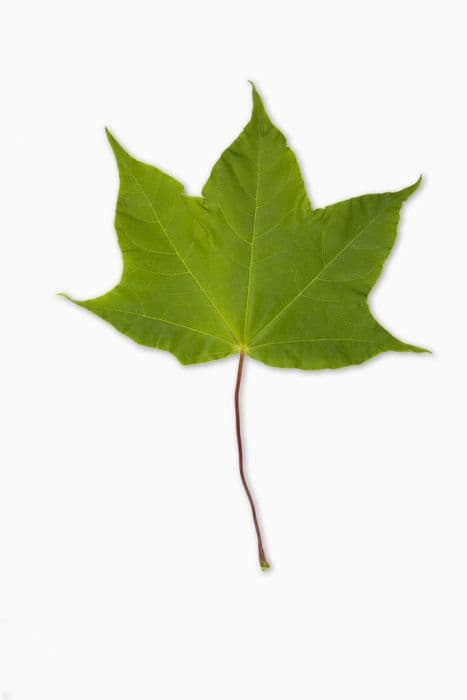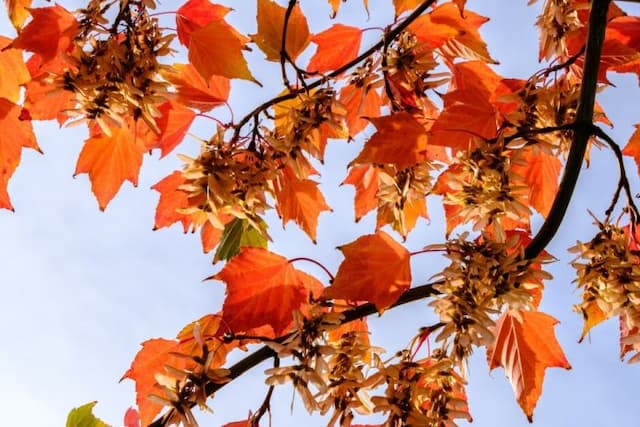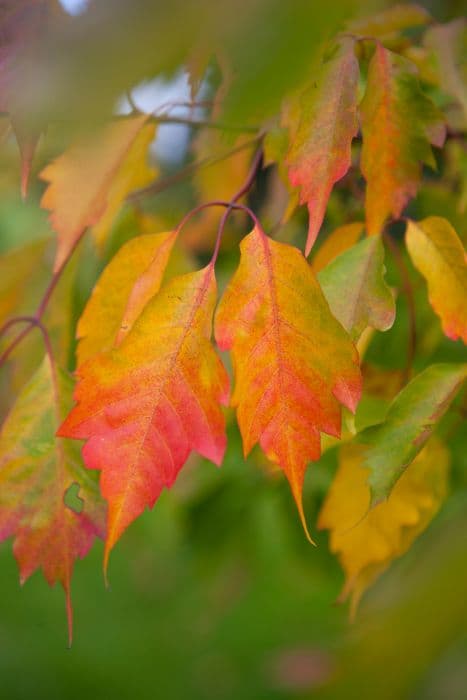Japanese Maple Acer palmatum 'Fireglow' (A)

ABOUT
The Japanese Maple 'Fireglow' is renowned for its striking and vibrant foliage. This ornamental tree showcases leaves that are a deep red tone, which resemble the glow of a fire, hence its name 'Fireglow'. The leaves are finely cut and palmate, radiating out like fingers from the palm of the hand, contributing to a delicate and feathery appearance that softens the overall silhouette of the tree. As seasons change, so does the color palette of its leaves, presenting a dynamic display throughout the year. The spring brings fresh, fiery-red new growth, which subtly transforms into a richer, burgundy red during the summer months. Come fall, the foliage warms into a brilliant array of reds, creating a standout spectacle in the garden. The branching structure of the Japanese Maple 'Fireglow' adds to its ornamental value, with gracefully arching branches that provide a harmonious structure even in the absence of leaves in the winter. The bark and stems exhibit a smooth texture with a complementary color that underscores the overall elegance of the tree. This combination of exquisite leaf color and graceful growth habit makes the Japanese Maple 'Fireglow' a prized specimen for garden enthusiasts looking for year-round visual interest.
About this plant
 Names
NamesFamily
Sapindaceae
Synonyms
Fireglow Japanese Maple, Fireglow Red Leaf Japanese Maple
Common names
Acer palmatum 'Fireglow'
 Toxicity
ToxicityTo humans
The Japanese Maple is not considered toxic to humans. It is generally regarded as a safe plant in gardens and landscapes where humans, including children, are present. No significant toxic effects are expected following ingestion of parts of this plant. However, as with any plant material, individual allergies or sensitivities can occur, so it is advisable to handle plants with care and avoid ingesting them, especially when their edibility status is not confirmed.
To pets
The Japanese Maple is not known to be toxic to pets such as dogs and cats. It is typically safe when grown in an environment shared with pets, and poisoning is not typically a concern. However, in rare cases, some animals may have a sensitivity or an allergic reaction to a plant that is generally considered non-toxic, so it is always best to monitor pets and prevent them from chewing on any type of landscape plants.
 Characteristics
CharacteristicsLife cycle
Perennials
Foliage type
Deciduous
Color of leaves
Red
Height
6-8 feet (1.8-2.4 meters)
Spread
6-10 feet (1.8-3 meters)
Plant type
Tree
Hardiness zones
5-8
Native area
Japan
Benefits
 General Benefits
General Benefits- Visual Interest: A. palmatum 'Fireglow' provides striking foliage color throughout the seasons, with fiery red leaves in spring and summer, and intense crimson hues in fall.
- Landscape Design Versatility: 'Fireglow' can be used in a variety of landscape designs, including focal points, foundation plantings, and as part of mixed borders.
- Size: It is a compact tree, usually reaching only 12-15 feet, making it suitable for small gardens or spaces where a full-size tree would be too large.
- Shade Tolerance: This variety can thrive in partial shade, providing flexibility in garden placement and landscaping options.
- Low Maintenance: The 'Fireglow' Japanese Maple is relatively low maintenance, requiring minimal pruning and is less prone to leaf scorch than other full-sun red maples.
- Seasonal Dynamics: It offers dynamic seasonal changes that entertain and change the feel of the garden throughout the year.
- Improved Mood and Well-being: The aesthetic beauty of the tree can contribute to a sense of well-being and enjoyment for homeowners and garden visitors.
- Increase Property Value: Attractive landscaping with specimens like 'Fireglow' can increase property values by enhancing curb appeal.
- Wildlife Habitat: This plant can provide cover and occasionally food for birds and other wildlife in the garden.
- Cultural Significance: Japanese Maples have a rich history and are often associated with peace and tranquility, adding a philosophical or cultural layer to the gardening experience.
 Medical Properties
Medical PropertiesThis plant is not used for medical purposes.
 Air-purifying Qualities
Air-purifying QualitiesThis plant is not specifically known for air purifying qualities.
 Other Uses
Other Uses- Acer palmatum 'Fireglow' can be used in photography as a stunning backdrop for portraits, especially during autumn when the leaves offer a dramatic palette of colors.
- The intense color of the Fireglow Japanese Maple's foliage can be used in color therapy practices to promote a sense of energy and vitality.
- Artists may use the leaves of this plant for botanical illustration, capturing the unique color and shape of its foliage.
- Its branches and leaves can be incorporated into floral arrangements or used as a natural decorative element in home décor.
- Culinary artists can use the leaves as natural food coloring or garnish in gourmet dishes, ensuring they're safe to eat and non-toxic.
- The bark and leaves of the plant, consistent in color, can be used in creating natural dyes for textiles and crafts.
- Leaves of the Fireglow Japanese Maple may serve as a natural confetti for outdoor celebrations, adding an eco-friendly touch.
- This plant can act as a living sculpture in a garden, serving not only as a botanical element but also as a focal point for landscape design.
- The wood from pruned branches can be used for woodworking projects such as creating small decorative items or inlays.
- In Bonsai form, the Fireglow can be an educational tool for teaching the art and science of Bonsai, as it is a popular species used in this traditional practice.
Interesting Facts
 Feng Shui
Feng ShuiThe Japanese Maple is not used in Feng Shui practice.
 Zodiac Sign Compitability
Zodiac Sign CompitabilityThe Japanese Maple is not used in astrology practice.
 Plant Symbolism
Plant Symbolism- Change and Transformation: The 'Fireglow' Japanese Maple is known for its vibrant, fiery red foliage that changes color with the seasons, symbolizing the ever-shifting nature of life and the ability to adapt to change.
- Peace and Tranquility: In Japanese culture, maples are often associated with calmness and serenity, making them popular in Zen gardens and spaces dedicated to reflection and meditation.
- Balance and Harmony: With its symmetrical shape and balanced growth, this cultivar represents equilibrium and reminds us of the importance of maintaining harmony in our environments and personal lives.
- Endurance and Strength: Despite being a delicate-looking tree, the 'Fireglow' Japanese Maple can withstand a variety of climates, representing resilience and the ability to endure challenging circumstances.
- Beauty and Elegance: Known for its aesthetic appeal, the tree is admired for its ornamental qualities, exemplifying both physical beauty and inner grace.
 Water
WaterJapanese Maples like Acer palmatum 'Fireglow' should be watered deeply once a week during the growing season, especially if there hasn't been substantial rainfall. It's important to keep the soil consistently moist but not waterlogged. An approximate amount would be to use 10 gallons of water for a mature tree, ensuring you water slowly at the base to allow for deep soil penetration. In hotter temperatures or during a drought, increase the frequency to twice a week. Reduce watering in the fall and water sparingly in winter only if the ground is not frozen.
 Light
LightJapanese Maples, such as 'Fireglow', thrive in locations with dappled sunlight or part shade. They can tolerate full sun in cooler climates, but in hotter areas, they should be protected from the intense afternoon sun. The best spot for ‘Fireglow’ is one where it can enjoy morning sun and be shielded from the hot midday and afternoon sun to prevent leaf scorch.
 Temperature
TemperatureJapanese Maples like 'Fireglow' are tolerant to a range of temperatures but perform best when the climate is between 60°F and 80°F. They can survive in temperatures as low as -20°F and should be protected if the temperature starts to exceed 90°F. To ensure the health of 'Fireglow', avoid placing it in sites where temperature fluctuations are frequent and severe.
 Pruning
PruningPruning 'Fireglow' Japanese Maple is best done to remove dead or damaged branches and to shape the tree for aesthetic purposes. Prune in late winter or early spring before new growth starts, as pruning at this time reduces stress on the tree and helps prevent bleeding of sap. Pruning is typically done annually or as needed to maintain the desired shape.
 Cleaning
CleaningAs needed
 Soil
SoilJapanese Maple 'Fireglow' thrives in well-draining, consistent moisture-retaining soil with a pH of 5.5-6.5. The best soil mix is one-part peat moss to one-part pine bark and one-part coarse sand or perlite for aeration.
 Repotting
RepottingJapanese Maple 'Fireglow' should be repotted every 2-3 years to prevent root crowding and to replenish its soil.
 Humidity & Misting
Humidity & MistingJapanese Maple 'Fireglow' prefers moderate to high humidity but can tolerate a range of humidity levels as long as soil moisture is maintained.
 Suitable locations
Suitable locationsIndoor
Place in bright, indirect light & protect from dry heat.
Outdoor
Provide partial shade, shelter from strong winds.
Hardiness zone
5-8 USDA
 Life cycle
Life cycleThe Japanese Maple 'Fireglow,' typically begins its life cycle when a seed germinates in spring, once the weather warms and soil moisture is adequate. Following germination, the seedling emerges and establishes itself, focusing on root development and leaf growth to harness sunlight and nutrients. As the maple transitions to a juvenile stage, it starts to develop its characteristic palmate leaves and produces a more robust root system. Throughout its maturing phase, 'Fireglow' experiences significant vertical and horizontal growth, forming a distinctive branching structure and brilliant red foliage, which intensifies in autumn. Upon reaching maturity, which can take several years, the tree begins its reproductive stage, developing small, red or purple flowers that give way to samaras, the winged seeds. Finally, as it enters the senescence phase, growth slows, and the Japanese Maple 'Fireglow' may show signs of decline before eventually dying, completing its life cycle.
 Propogation
PropogationPropogation time
Early Spring
The Japanese Maple 'Fireglow' is best propagated through softwood cuttings taken in late spring or early summer when the plant's growth is most vigorous. To propagate by cuttings, choose a healthy, non-flowering shoot and cut a 4 to 6-inch (10 to 15 cm) length, making the cut just below a node. Strip the lower leaves, leaving a few at the top, and dip the cut end in rooting hormone powder to enhance root formation. The cutting should then be planted in a moist potting mix, ensuring at least one node is buried where roots can form. Cover the cutting with plastic to maintain humidity and place it in indirect light until roots have developed, which usually takes several weeks. Once rooted, the cutting can be transferred to a larger pot or planted directly into the garden. Regular watering and avoidance of direct sunlight will help the new Japanese Maple 'Fireglow' plant to establish itself.









